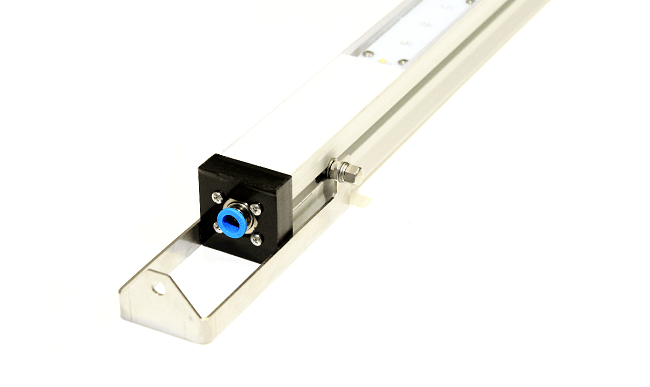
A quick growth of the plant and good harvest in a greenhouse requires not only water and soil. A proper level of light is also very important. Very often growers make a serious mistake installing many HPS lamps and putting them close to the plants. HPS lamps emit a lot of heat. Moreover, the lamp located close to the plant can burn leaves. LED grow lighting is one of the most promising types of supplemental lighting for greenhouses, so let’s look at this in more details as this lamps have a lot of advantages in comparison with other types of lamps and also because it is the new stage of development of horticultural lighting. A shortage of light is a serious issue in the winter season, when daylight is short and when the sunlight is absent or is not enough for efficient growing. Vertical farms or - more widespread in Europe - vertical farm containers are good examples of such farms. But first things first.
Why do plants in the greenhouse need LED lighting?
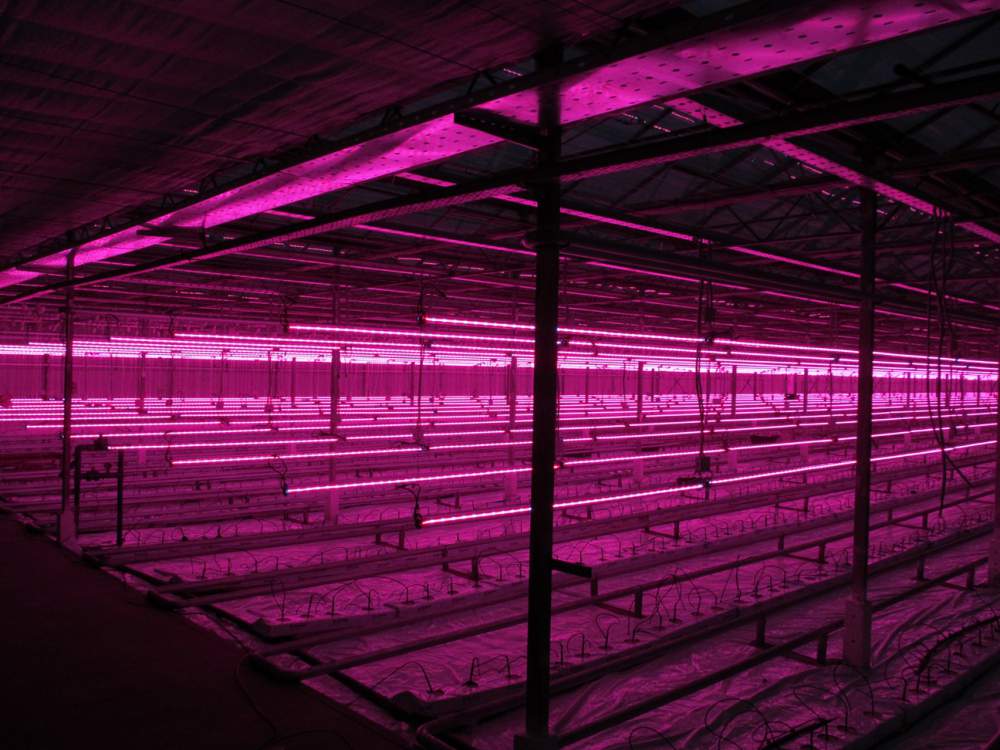
Today several schemes for the use of artificial LED grow lights exist:
- Supplemental. To boost photosynthesis. In this case LED grow lights are used in combination with natural sunlight;
- Periodic. Supplemental LED lighting is used just to have a possibility to control the daylight period;
- Full sunlight substitute. This scheme maximizes the process of control plant growth. It is worth noting that the total replacement of daylight is used only in rooms with a climate-controlled environment. Only by maintaining the balance it is possible to rich the optimal growth speed of the plant.
Before installing LED grow lights in the greenhouse, it is important to figure out the benefits of it for plants. Let’s check our the role of lighting in plant grows.
There is a complex chemical process that takes place in plants: from simple molecules, gigantic organic chains are constructed, that form the plant itself. For any process, energy is needed, and in real life conditions, plants use sun rays to get it. A light photon enters the leaf and launches biochemical reactions, the result of which is weight increase- roots, stems, leaves
The artificial lighting must provide the assimilation lighting, which is needed for plant growth. LED assimilation lighting allows to increase the harvest from each square meter and to reduce a period of cultivation. LED grow lights with specific light spectrum are a perfect solution. If the lamps do not solve this problem, it will emit only the heat that will harm plants in future.
What is the quantity and quality of LED light needed for growing plants?

Each plant species have different light requirements, that differ also in the stage of plant development. All cultured lights like the sun, some of them to a greater extent than others. Most light is needed for nightshade veggies, peppers
Supplemental LED lighting in greenhouses is really important in winter, spring
According to spectrum sensitivity of plants, one should take into account not only the total flux of light but also its spectrum. In other words, not every LED grow light is suitable for supplementary lighting of plants in a greenhouse. The more light emitted in the right part of the spectrum to which the plant is susceptible, the more effective it will affect the growth of the plant. We make assimilation light planning considering the characteristics of the system for each crop. LED grow lighting system does not interfere with other systems of greenhouses, including, for example, shading system. We guarantee competent calculation of LED grow lights systems in order to avoid power losses and get the best harvest in your greenhouse.
Why different plants need a different amount of LED light
(DLI- daylight integral)?
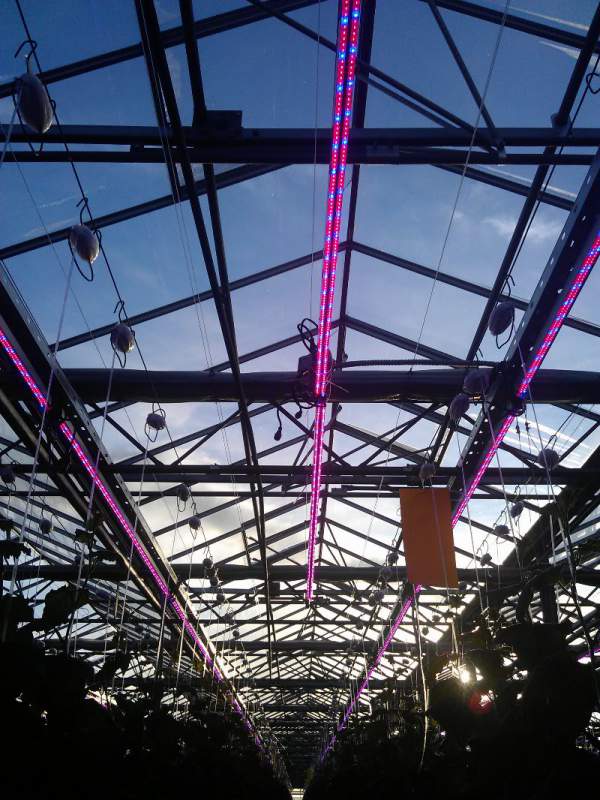
All plans perceive the light in a different way. It must be taken into account when you run LED grow lights in your greenhouse.
According to the requirements of the illumination, all plants can be divided into three groups.
- Photophilous. In nature, it grows in the open space. They can not tolerate even a slight shading. Plants of this group prefer the light level is not less than 10 thousand lux and more.
- Mid Photophilous. Plants which requires a light level of 3-5 thousand lux.
- Shade tolerant. Can grow with a light level of 500-1000 lux.
The cucurbits and nightshade plants are the short or neutral DLI plants. Cabbage, root vegetables will flower at long day, which in this case is not wanted. Some confusion can be done with decoration plants as there is a large variety of those, and there is sometimes not enough information to what DLI will the new flower type belongs.
Some flower breeds are so special, like Callistephussinensis, which will need a combination of short and long DLI. The rule of thumb is that tropical plants belong to short day plants and northern to long day type. The plants need light at all development stages. But even short day plants and most of greenhouse cultivated ones belong to them, stop growing of light duration is less than 10 hours.
Therefore if plants don’t grow or flower, the seedlings stretch, the growers have to add supplemental LED grow lighting system to the greenhouse. The most difficult thing is to select the LED lamps for grow lighting, as there is
Lack of light:
1. The first and most sure sign of light lack is a leaf fall. The plants try to compensate the lack of light by a reduction in leaf area;
2. It is also necessary to pay attention to the light mode set for the plant. In that case, the lower leaves of the plant start to turn yellow and dry.
3. Fruiting plants do not bloom in a proper time or do bloom, but their flowers are smaller and lower in quality as it regarded for this type of crops.
4. Usually, colorful leaves of the plant become simply green;
5. Evidence of growth is absent, elongated stems with long internodes.
Excess of light:
1. Leaves become faded;
2. The flowering plant begins to bloom as usual, but quickly fades in the way that is not typical for this plant;
3. Brown or gray spots appear on leaves because of burns;
4. Leaves bowed;
5. Leaves of shade-requiring plants shrivel and shink off. Of course, many of these symptoms may also be a sign of other problems, so if you want to be pleased by the harvest the problems must be approached comprehensively.
Let's define what kind of LED grow lights are suitable for supplementary lighting of plants in greenhouses.
LED grow lights are pretty new but are gaining more popularity in greenhouse applications. As it was mentioned before, light is absolutely needed for plants. Very often natural daylight is not sufficient for plant development and flowering in greenhouses, especially in autumn and winter season. For this reason, artificial lights are used for greenhouse supplemental lighting. There is a number of lamps used for general lighting, but few of them are optimized for plant growing in greenhouses, indoor gardens, and vertical farms. Therefore special lamps with optimized spectrum are used for horticultural applications. There are few technologies used for special lights for horticulture, like HPS, MH and LED specialized lamps. Let’s focus on the latter. Although LED grows lights are relatively new for plant growth, they are rapidly taking their market share in horticulture.
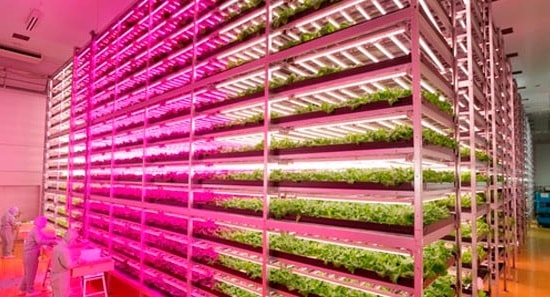
Not all LED lights are good for assimilation lighting in greenhouses. It is important to take into consideration wavelength of individual LEDs, as well as the LED ratio. In other words, light spectrum is very important for light planning to supplement or substitute light. There is a direct connection between photosynthesis and spectrum and daylight integral (DLI) of photosynthetic radiation (PAR). Most efficient wavelengths for photosynthesis are red 660nm and blue 430-450nm with a large ratio of blue in the spectrum are best in propagation and vegetation stages. Blue spectrum helps develop growth inhibitors that promote plant formation, improve stem and leaves density and thickness. Light with larger red spectrum ratio, especially with the peak in 660nm is best for flowering and fruiting, root development. In supplemental lighting red and blue parts of PAR spectrum are most efficient for plants development and growth, other spectra are less effective to use in grow
How to choose LED grow lights: advantages and disadvantages
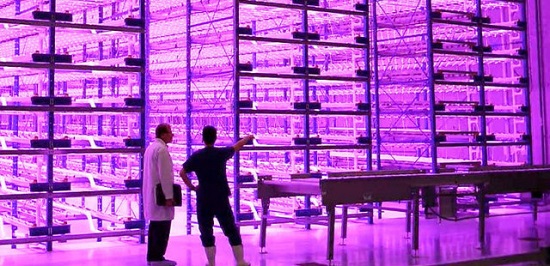
LED grow lights are complex lighting apparatus and its performance largely depends on technical specification, read more details here. To chose LED plant lights one must take into consideration such factors as what plant type you will need to grow, plant development stage and area of lighting. In contrast to HID lamp technology where light is emitted in 360-degree
The critical technical characteristics of LED grow lights are:
- Photosynthetic Photon Flux (PPF). It is the number of photons in the PAR spectrum per second. It is measured in µmol/s, and the only way to measure PPF of the plant grow light is in an integrating sphere from the whole fixture.
- Photosynthetic Photon Flux Density (PPFD). It is the number of photons that fall from grow LED lights on a square meter of surface per second. It is measured in µmol m-2 s-1. Quantum meter is used to measure this parameter. PPFD from a grow light largely depends on a total PPF of an LED grow light and optical system and its mounting height.
- Spectrum. Like it was mentioned before, some parts of PAR spectrum are less efficient than other parts, but exact spectrum composition depends on the type of plant and its development stage and growing conditions (without sunlight, insufficient sunlight). Even with a lot of PPF plants may get light in less efficient PAR spectrum, e.g. green and yellow-orange, thus reducing grow light’s efficiency for photosynthesis.
- Efficiency. The efficiency of grow lights represents the ratio of emitted photons per watts consumed. Quality LED plant lights will have up to 2,7umol/W efficiency. Again, it is important to direct that PPF to the pants you need to light, so optical system is critical for getting the right PPFD and minimizing stray light. Only after you know real efficiency, not claimed power consumption, you can judge of LED light quality.
- Dimensions. In greenhouses, plants get the perfect light from the sun. They have used sunlight for millions of years for photosynthesis, so there is no reason why they should not be getting as much sunlight as needed. Large, bulky HID fixtures have large shadow footprint preventing sunlight from entering plant surface. The smaller the LED grow light fixture, the smaller is its shadow, the more natural sunlight plants get. This parameter though is not so important in grow rooms and other conditions where plant don’t get any sunlight.
- Emission angle. Unless you grow a single plant, a wide emission angle of light LED grow is needed to evenly cover a larger area. This can be done by both selecting suitable secondary optics for LEDs with the right light curve and by the whole system installation layout. The best way to get your project done right is to provide all details for calculations to professional companies that install lights in greenhouses.
- Heat management. LEDs do not emit as much light as HID lamps do. However, there is still a heat problem. It does not affect that much plants, but it is a serious issue for growing light longevity and efficiency. The higher the temperature on LED is, the higher degradation of optical output and lifetime is. Several options are used for managing heat from LED in a fixture. One is passive cooling with the use of aluminum heat sinks. Another is active cooling, usually done with the help of fans, but there are some companies that offer more exotic methods like water cooling. We have both active and passive cooled LED grow lights, although we consider passive cooling for large-scale professional projects is better.
- Voltage. The most common voltage in LED grow lights that one may meet is universal 110-265VAC. This mains voltage is suited for households in most parts of the world. However, greenhouses usually install 400VAC input lights. We have both universal input LED lights and work on developing 400VAC fixtures.
- Ingress Protection (IP). IP rating is very important for LED
Our company has a wide range of professional and advanced series or sale for your horticulture projects. Powers vary from 9W for multilayer vertical farm projects where lower PPFD is needed to actively cool 1600W monsters widely used in medical marijuana growing industry.
Photosynthesis is greatly affected not only by an intensity and spectral compositions but also by lighting schedule, or a ratio of time a plant spent under light and in the darkness. Some plants morphology and vegetation/flowering stages can be manipulated by altering lighting time. Increasing daylight integral in short day plants may cause flowering stage disruption. Some plants are daylight period neutral, e.g. roses that are not affected by the period of lighting. Before installing LED lights one must find our light preferences of the plants they will be growing.
Placement LED grow lights.
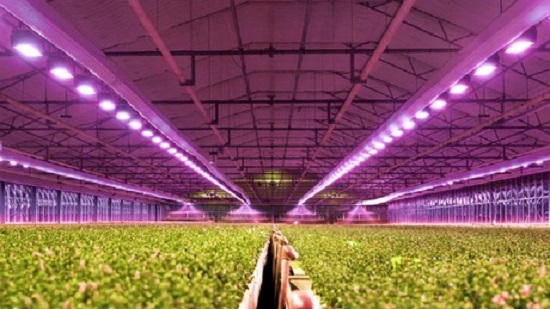
It can be placed very close to plants, as they don’t emit much heat and can not burn leaves. Depending on the power of LED light, the distance can be as low as 10cm from the plant. This can be achieved with suspended plant grow lights. Ropes can help adjust the needed distance from the plant. LED grow light placement is of great importance to plant development.
Advantages of LED grow lights:
- As it was mentioned before, LEDs can allow spectrum optimization with a focus on
- LED lights do not emit much heat, that allows them to be placed very close to plants, and even between plant canopy. Obviously, fire hazard of these lights is minimal.
- LED lights do not contain mercury and other hazardous substances and conform to ROHS standards.
- Small size, low weight, and no bulky ballasts are the features that allow LEDs to be used both in greenhouse and vertical farm growing.
- Up to 50% power consumption economy compared to HPS lamps. This is especially crucial on new projects, as savings will come also from lower power and lower cost electrical power facilities in the greenhouse.
Disadvantages of LED grow lights:
- Although more efficient than many conventional light sources used in horticulture, they come with a substantially higher price tag.
- No standards developed yet for use it in LED horticultural lighting.
- Relatively new technology that will be improving year after year.
Summary
In conclusion, we want to underline that a greenhouse is a complex system in which lighting plays an important role. Knowing the demands of vegetable crops to the light intensity, you can adjust it using the LED grow lights. With help of LED lighting in a greenhouse, you can artificially increase the period of daylight, providing the most stable and rapid growth of plants, and as a result the optimal harvest.
Best LED Grow Lights for Greenhouse 2019

